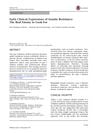Clinical, Laboratory, and Trichoscopic Features of Pediatric Androgenetic Alopecia: A Retrospective Analysis in 133 Patients
May 2024
in “
Research Square (Research Square)
”

TLDR Pediatric androgenetic alopecia is linked to obesity, family history, hormonal imbalances, and requires personalized treatment including managing comorbidities.
The retrospective study conducted by Jiangsu Province Hospital over 14 years analyzed 133 pediatric patients with androgenetic alopecia (AGA), with symptoms appearing as early as 8 years old. The study found that 39.8% of the patients were overweight or obese, 78.2% had a family history of AGA, and several had comorbidities like seborrhoeic dermatitis (51.9%), acne (42.9%), and sleep disorders (28.6%). Hormonal imbalances were common, with 47.1% having low sex hormone-binding globulin, 61% having vitamin D deficiency, and 23.6% having low ferritin. Male AGA patterns were characterized by crown thinning and temporal variations, while females showed crown thinning with frontal hair retention. The study emphasizes the need for individualized, stepwise, and comprehensive treatment, prioritizing hormonal disorders and comorbidities when treating hair loss with topical minoxidil. Regular medication and follow-up appointments were encouraged for favorable outcomes.














